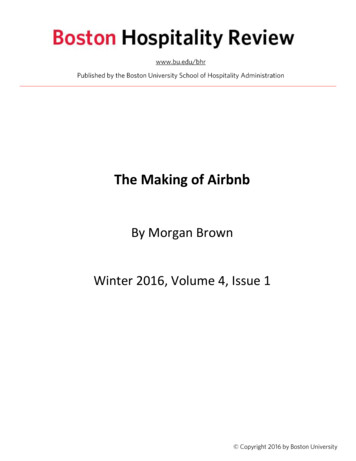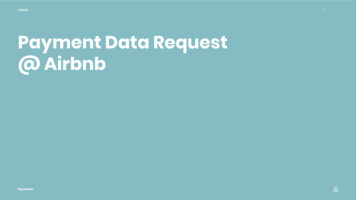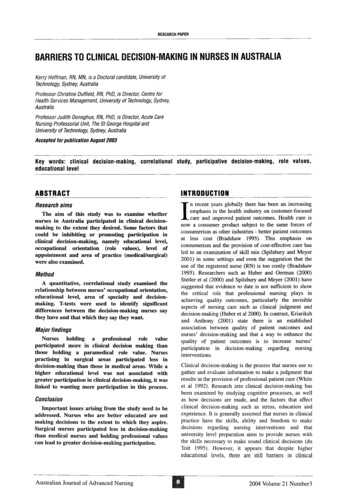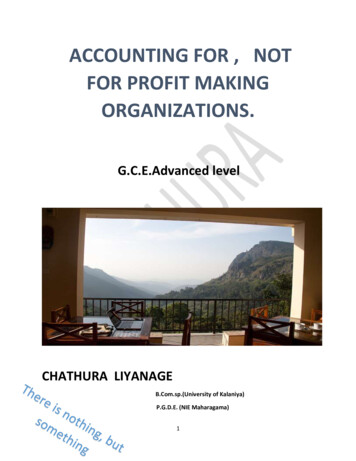
Transcription
The Making of AirbnbBy Morgan BrownWinter 2016, Volume 4, Issue 1
1 Airbnb website homepage (Image via Airbnb)By Morgan BrownShortly before Thanksgiving of 2015, it was announced that Airbnb had raised 100 million at avaluation of 25.5 billion. That 100 million was a drop in the bucket compared to the warchest of 1.5 billion the company raised earlier in the summer, raised on the back ofincreasingly strong growth. The company reported revenues in the third quarter of 2015 at 340 million, on track for just shy of 1 billion in total revenue for the year. Nights booked, thecompany’s metric of choice, continues to see incredible year over year growth, estimated at thetime of the announcement to hit 78 million nights in 2015, nearly double their 2014 bookings.pg. 1
Firmly atop the unicorn heap--the Silicon Valley slang for companies worth more than 1 billionin private valuation--Airbnb has turned itself into an international brand to be reckoned with,and only its own stumbles or government regulation seem to stand in its way on the path tolong-term success.Over the last two years I’ve spent thousands of hours dissecting what makes companies likeAirbnb tick, and how they, among all others, found breakthrough success. What I’ve found inthem all is an organizational DNA imbued with a singular passion for driving growth. WhileAirbnb works hard at it’s brand image, success at the company is driven by calculating,relentless focus, and an internal growth culture that drives it’s stratospheric performance in asystematic way.While we all love to tell stories of “once in a generation” ideas that succeed on their ownmerits, the truth is always messier. A business idea that seems like it was destined for successfrom the get-go, Airbnb was far from certain in the early days, with failure not further than afew boxes of cereal away at any moment. (Keep reading.) Flush with cash and Chip Conley’sculture infusion, the company today likes to talk more about brand and experience, butunderneath, a driven team focused on growth continues to spur the company forward.pg. 2
The Beginning of AirbnbIn 2007, designers Brian Chesky and Joe Gebbia couldn’t afford the rent on their San Franciscoapartment. To make ends meet, they decided to turn their loft into a lodging space, but, asGebbia explains, “We didn’t want to post on Craigslist because we felt it was too impersonal.Our entrepreneur instinct said ‘build your own site.’ So we did.”[1]There was a design conference coming to town and hotel space was limited, so they set up asimple website with pictures of their loft-turned-lodging space—complete with three airmattresses on the floor and the promise of a home-cooked breakfast in the morning. This sitegot them their first three renters, each one paying 80, and after that first weekend they beganreceiving emails from people around the world asking when the site would be available fordestinations like Buenos Aires, London, and Japan. Gebbia explains, “People told us what theywanted, so we set off to create it for them. Ultimately while solving our own problem, we weresolving someone else’s problem too.” [1]The following spring, they enlisted their former roommate, Nathan Blecharczyk, to help themget Airbed & Breakfast off the ground. Fast forward eight years, and Airbed and Breakfast isnow Airbnb—a household name that has surpassed industry stalwarts like Hilton Hotels innights booked. But how did a few air mattresses on the floor become the most widely-usedanecdote for breakout startup growth?Early Growth from Pure HustleAs they were starting out, the founders needed a way to raise money. In an ingenious movethat would soon be a hallmark of their creativity, they bought a ton of cereal and designedspecial edition election-themed boxes—Obama O’s and Cap’n McCain’s. They sold 500 boxes ofeach cereal, helping them to raise around 30k for their new venture.2 Image via TechCrunchStill, the Airbnb idea did not gain much traction, and the founders resorted to living off ofleftover Cap’n McCain’s (the Obama O’s sold out)—a time they refer to as a real “low point.”The following spring they had dinner with Paul Graham, the founder of prestigious Silicon Valleyincubator Y-Combinator. The incubator is a veritable hit factory, backing companies such asReddit, Dropbox, Stripe and others. Despite recognizing the startup’s potential, Graham admitsto having his doubts, explaining "I thought the idea was crazy. Are people really going to dopg. 3
this? I would never do this."[4] Nevertheless, Airbed & Breakfast soon joined Y Combinator’s2009 winter class. [2]It wasn’t just Airbnb’s business model that posed a concern. When Gebbia and Chesky—both ofwhom are Rhode Island School of Design alums—were initially seeking funding for their startup,investors didn’t know what to make of a company with two designers.[4] Yet it was most likelythis design background that helped Airbnb to find such innovative, unexpected solutions, anability that informs much of Airbnb’s growth strategy today.Breaking Out: Craigslist and the Makings of Silicon Valley LegendIt’s unclear exactly when Airbnb implemented what’s become their most infamous growthstrategy, a long-since-abandoned (unauthorized) integration with Craigslist that unlocked atorrent of free users, but there is evidence of the strategy starting as early as 2010. [6] Thoughthe startup worked hard to distinguish themselves from the more impersonal super platform,Craigslist had one thing that Airbnb did not—a massive user base. Airbnb knew that Craigslistwas the place where people who wanted something other than the standard hotel experiencelooked for listings.In order to tap into this market, Airbnb offered users who listed properties on Airbnb’s site theopportunity to post them to Craigslist as well—despite the fact that there was no sanctionedway to do so. So Airbnb built a bot--a small computer script--to simulate a user’s visit toCraigslist, and automatically create a listing on Craigslist without any additional effort from theperson posting the listing on Airbnb. Once complete, the bot would forward the URL to the userfor publishing—as Rishi Shah documented in the screenshot below.3 Image via Getting More AwesomeThe bot also filled out a handful of forms, inputting the proper Craigslist category and regionand replacing the anonymous email assigned by Craigslist with a link to the Airbnb listing. Toensure that the listing stood out, the bot made the most of the platform’s limited HTMLsupport during publishing as well. As Andrew Chen, a Silicon Valley growth expert, explains:"This kind of integration is not trivial. [I]t could only have come out of the mind of anengineer tasked with the problem of acquiring more users from Craigslist.” [7]pg. 4
With the integration, Airbnb had unfettered access to Craigslist’s massive audience. To boot,the Airbnb listings were far superior to the other properties available—with more personaldescriptions and nicer photos—which made them more appealing to Craigslist users. CuriousCraigslist users hopped over to Airbnb in droves, and the rest, as they say, is history. [7] Whilethe integration violated the terms of service for Craigslist and automated posting, many viewthis technical workaround a piece of ingenious engineering and marketing. This “growth hack”has become a thing of Silicon Valley legend, with it used as an example of what can be whenmarketing and engineering work together, as well as a cautionary tale of drifting into murkyethical decisions when it comes to growth.Airbnb Gets Greedy on CraigslistWhile the first integration got much needed traffic to Airbnb listings fromCraigslist the companysaw another opportunity for getting more users to list their properties on Airbnb in the firstplace. This time, Airbnb went from clever to spammy, trying to get the most out of theplatform. Dave Gooden, who works in the vacation rental sector, says that in late 2009 hebegan looking into Airbnb’s mysterious growth. He explains: “In my AirBnB research, Icouldn’t find any rational or traditional reasons for this type of growth. All of these AirBnB userscan’t be coming from tech blogs, can they? Word of mouth? I didn’t think so. After thinking onit for a day or two, only one possible answer popped into my head: ‘These guys are black hats!’”[50]To test his theory that Airbnb was spamming the service to attract users, Gooden set up a“mouse trap” on Craigslist. Within a couple of hours, Gooden says he received an email from a“young lady” who really liked his property and wanted him to check out Airbnb. To make sure itwasn’t just an earnest fan, he listed additional properties, each time receiving similarly wordedmessages. As Gooden explains: “When you scale a black hat operation like this you could easilyreach tens of thousands of highly targeted people per day I am pretty sure that AirBnB isn’tthe only company that has used this strategy/technique, but I think they are the first to turn itinto a one hundred million dollar investment at a one billion dollar valuation.” [50]Though this hack isn’t as elegant as the first Craigslist platform integration discussed above—and it and it definitely constitutes spam—it certainly helped Airbnb to grow their listings quicklyand at almost no cost. And while the company was eventually shut out of Craigslist, theirtraction had already been cemented.Opportunistic Growth at Every TurnCraigslist shenanigans aside, Airbnb’s focus on the customer is a continual spring of new ideasthat unlocked new growth. In the summer of 2009, Airbnb wasn’t gaining much traction in NewYork, so Gebbia and Chesky flew out and booked spaces with 24 hosts to figure out what theproblem was. As it turned out, users weren’t doing a great job of presenting their listings.According to Gebbia, "The photos were really bad. No one was booking because you couldn'tsee what you were paying for."Their solution was low-tech but effective. The pair rented a 5,000 camera and went door todoor, taking professional pictures of as many New York listings as possible. The new photospg. 5
resulted in two to three times as many bookings on New York listings [2], and by the end of themonth Airbnb’s revenue in the city had doubled.What was stunting growth in New York was also stunting growth in Paris, London, Vancouver,and Miami.[4] This led to the Airbnb photography program, which launched in the summer of2010. Hosts could automatically schedule a professional photographer to come and photographtheir space.[4] Though this initiative wasn’t cheap, the enhanced listings from this program aretwo and half times more likely to be booked, and they earn their hosts an average of 1,025 permonth— they were well worth the cost.4 Image via Analytics Lessons LearnedNo detail escaped that type of applied learning and optimization, right down to the smallmatter of saving favorite properties on the site. In this case, the team decided to test changingthe generic star icon users used to save a property to a heart, and they were surprised to whenengagement increased by 30% as a result of that simple change.The company tests things big and small, including their international expansion strategy. InAugust of 2014, Airbnb’s Rebecca Rosenfelt gave a talk entitled “Going for Global,” in which sheoutlined some of the company’s international growth strategies, including a test in France todetermine the optimal way to launch new international cities. Airbnb randomly selected half ofthe international launch cities to physically visit, and half to target using Facebook ads. [51]Airbnb kept meticulous track of what it cost to send people and the listings that resulted, andcompared that to the Facebook ads and resulting listings in the markets they didn’t visit. Itturned out that cost per acquisition was 5x better for actually sending people into markets. Notonly that, but after “kickstarting” these markets with a human presence, they kept growing 2xfaster by themselves.Yet another example of their scientific approach to growth is the work the company has doneto maximize opportunity on mobile devices, including giving users the ability to invite newfriends to Airbnb. By October of 2013, around 50% of hosts were using the mobile app [34], andthose hosts tended to respond to guests three times faster than those on desktop. [36] Aspg. 6
Chesky explains, "Can you imagine if every Uber driver had to go home first to check theirlaptop in order to find their next ride?" [24]In late 2013, Airbnb decided to relaunch their “underutilized and underperforming” [53]referral program. Gustaf Alströmer, Growth Product Manager at Airbnb, describes the referralsystem as something they weren’t proud of. After 3 months and 30,000 lines of code, Airbnb’sreferrals program relaunched in January of 2014. As you would now expect, they immediatelyA/B tested all kinds of variables to learn as much as possible. It turned out that invites with aphoto of the sender helped to reinforce that feeling. Another A/B test involved the promotionalemails sent by Airbnb to potential referrers. When testing self-interested versus altruisticlanguage, they found that altruistic emails resulted in more invitations sent globally. [53]5 A/B testing was used to compare self-interested versus altruistic language in the Airbnb referral program. Image viaNerds.AirbnbAirbnb’s new referrals program resulted in hundreds of thousands of nights booked by referredusers in 2014,[52] and referrals increased booking as much as 25% in some markets. [53] Airbnbfound that referred users tend to be better than the average user—in other words, they’re notmerely in it for a free night. They tend to remain engaged with Airbnb and book future trips,and they are much more likely to send referrals themselves.Dodging ControversyAirbnb has not been without it’s stumbles and controversies. From nearly the beginning, thecompany has battled both renter and guest abuse, theft, and a raft of legislative issues fromgovernment and special interest groups. Airbnb has survived many of these issues primarilythrough its mostly proactive approach to resolving them. Airbnb has scaled their customersupport staff, create a dedicated Trust & Safety department, a Host Education Center withsafety tips for hosts, design enhanced userprofile verification, facilitate richer communicationbetween guests and hosts pre-booking, and offer insurance options to hosts—a 1,000,000pg. 7
Host Guarantee. Thanks to these measures the safety and liability concerns of 2011 are less ofan issue for Airbnb, although the stories of wild Airbnb guests continue to be hits in the press.Only July 16, 2014, Airbnb officially relaunched their site and mobile apps with an entirely newlook and feel which Chesky claims he was able to distill it all into a single concept—belonging.He explains, "Airbnb is about belonging anywhere. The brand shouldn't say we're aboutcommunity, or our international [reach], or renting homes—it's about belonging." [47]6 The company's logo, nicknamed Belo, stands for the universal symbol of belonging. Image via Fast Company.But the Bélo, the company’s nickname for its logo, hasn’t been received with excitement andpositivity all around. Some have noted that it seems to be a ripoff, [48] while others—inparticular, a Tumblr that was started the same day as the redesign—have made more crasscomparisons to genitalia. [49]The company’s biggest concern isn’t their logo, however, it’s dealing with blowback from thehotel industry, along with city and state officials—both of whom aren’t quite sure what to dowhen it comes to taxing and regulating Airbnb transactions. The hotel industry in New York Cityhas been particularly outspoken about their disdain and concern over Airbnb. The company’shome base of San Francisco is also in the midst of redefining and regulating the laws governingshort-term rentals. This back and forth between the hotel industry, state and local government,and landlords—all of whom want their share of the action—will be Airbnb’s biggest struggle asit seeks to deliver on its brand promise and continue to grow.As Chesky explained to Fast Company in early 2014, "Our business isn't [renting] the house—our business is the entire trip.” [23] As Paul Graham explains, "If you ask Brian now what drivesAirbnb's growth, it's not that people want to get a cheaper space. Airbnb could've spread outhorizontally into the sharing of power tools and cars and stuff like that. But Brian has decidedthe growth is in hospitality." [24] This focus lead to the hiring of Chip Conley, who joined thecompany out of semi-retirement after 24 years as CEO of Joie de Vivre. Conley, now Head ofGlobal Hospitality at Airbnb, has become one of Chesky’s most trusted advisers.pg. 8
Now flush with cash, a growth engine that shows no signs of slowing, and an emerging brand,the future of Airbnb is much of what it makes of it. Will they be able to navigate the city-by-cityregulatory hurdles to become an iconic hospitality brand? Or will the missteps catch up to themand ultimately upend the promise of the shared economy promised by Airbnb? It will be a sagathat will play out over the next handful of years; but one thing will be certain--the Airbnb teamwill be experimenting and optimizing their way through it to the end.Morgan Brown is the COO of Inman News and the co-author of “Startup GrowthEngines: How Today’s Most Successful Startups Unlock Extraordinary Growth”with Sean Ellis. A 15-year startup marketing veteran, Morgan most recently ledgrowth for GrowthHackers.com and Y-Combinator backed TrueVault. Previously,Morgan held marketing and growth leadership roles at ScoreBig, Science, andSmartShoot (formerly TurnHere). He publishes a semi-regular newsletter ongrowth at morganbrown.co. Follow Morgan on Twitter at @morganb.pg. 9
the startup worked hard to distinguish themselves from the more impersonal super platform, Craigslist had one thing that Airbnb did not—a massive user base. Airbnb knew that Craigslist . into a one hundred million dollar investment










